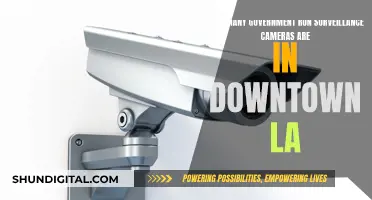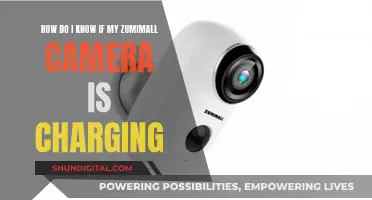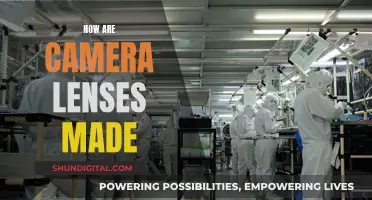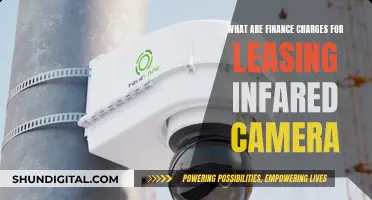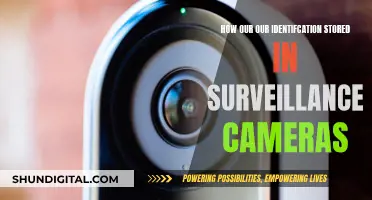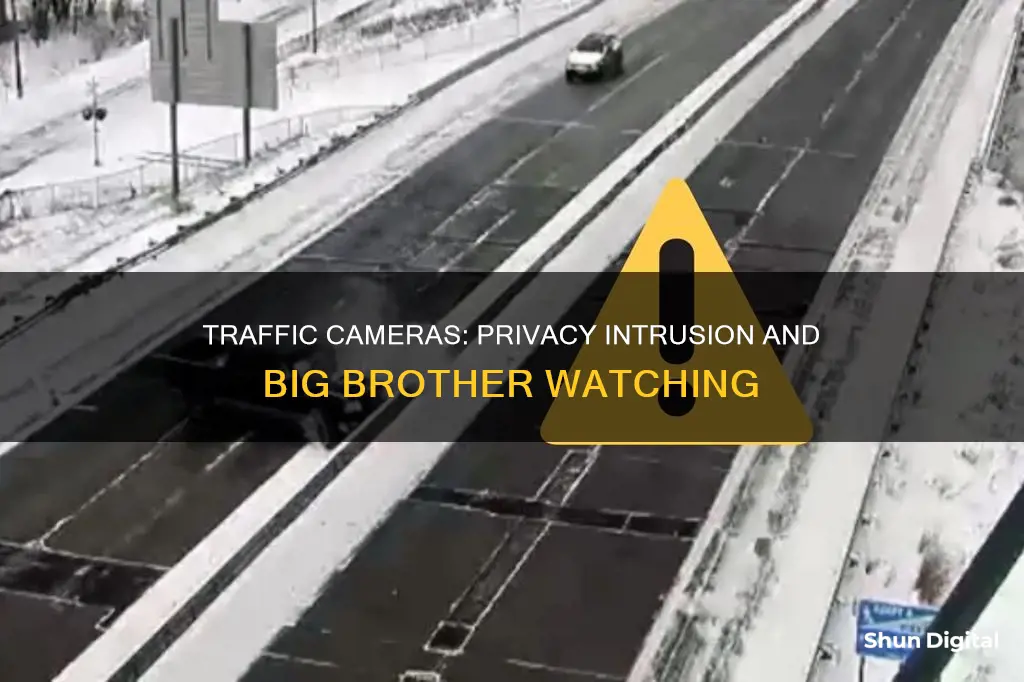
Traffic cameras are a contentious issue, with some people arguing that they invade their privacy and are a form of government overreach. While traffic cameras can help to reduce accidents and save lives, there are also concerns about their effectiveness and the potential for abuse. For example, in some cases, drivers may be incentivised to slam on their brakes to avoid a fine, increasing the risk of rear-end collisions. Additionally, the quality of traffic camera footage can vary, and it is not always stored for long periods, which can make it difficult to use as evidence in legal proceedings. Furthermore, the use of traffic cameras for ticketing purposes can vary across jurisdictions, making them less effective as a deterrent in certain areas.
| Characteristics | Values |
|---|---|
| Privacy concerns | Traffic cameras may be used for mass surveillance of vehicle movements and, by association, the movements of vehicle owners. |
| Loss of privacy | Automatic number-plate recognition systems can be used for purposes unrelated to enforcement of traffic rules, such as tracking the whereabouts of drivers. |
| Revenue source | The common use of speed traps as a revenue source undercuts the legitimacy of safety efforts. |
| Lack of human touch | Traffic cameras remove the human touch from the traffic ticket process. |
| Increase in accidents | Fear of fines may fuel more sudden stops and rear-end accidents. |
| Ineffective | Houston's red light camera program was ineffective in improving traffic safety. |
| Poor video quality | Traffic camera footage is often grainy or not sharply focused. |
| Lack of transparency | There is no map or directory of traffic cameras. |
What You'll Learn

They can be a violation of privacy
Traffic cameras can be a violation of privacy. The latest automatic number-plate recognition systems can be used for the detection of average speeds and raise concerns over the loss of privacy and the potential for governments to establish mass surveillance of vehicle movements and, therefore, by association, the movements of the vehicle's owner.
In the UK, an 80-year-old pensioner, John Catt, and his daughter, Linda, were stopped by the City of London Police while driving in London in 2005. Their vehicle was searched under the Terrorism Act 2000, and they were threatened with arrest if they refused to answer questions. It was later discovered that they were stopped when their car was flagged in the Police National Computer database when they were seen near EDO MBM demonstrations in Brighton. Critics say that the Catt family had been suspected of no crime, but the police ANPR system led to them being targeted due to their association with the demonstrations.
Some people argue that ANPR cameras are a good thing, as they can warn the police of possible danger. But this can also be argued as government overreach. There have been instances of using ANPR in low-income areas to drive through parking lots and impound many vehicles due to outstanding parking tickets.
Additionally, some groups, such as the American Civil Liberties Union in the US, claim that "the common use of speed traps as a revenue source also undercuts the legitimacy of safety efforts."
Traffic cameras are also controversial because they remove the human touch from the traffic ticket process. People believe police officers can more accurately assess reasons for a moving violation. For example, an officer can distinguish between a person who ran a red light because they did not have adequate time to stop and someone speeding for a personal issue. Traffic cameras remove that human touch and issue tickets without thought.
Furthermore, some US states and provinces of Canada operate "owner liability", where the registered owner of the vehicle is legally responsible for paying all fines, regardless of who was driving the vehicle at the time of the offence. In such jurisdictions, corporations that own vehicles (such as rental car companies) almost invariably require authorized drivers to agree in writing to assume financial responsibility for all such tickets.
Clipping Camera: Attaching to Your Computer Screen
You may want to see also

They can cause people to suddenly stop and be rear-ended
Traffic cameras, including red light cameras and speed cameras, can cause people to suddenly stop and be rear-ended. While these cameras are designed to improve road safety and reduce the number of vehicles running red lights, they can also have unintended consequences.
The presence of red light cameras may cause some drivers who would have otherwise proceeded through an intersection to attempt to stop abruptly. This can increase the risk of rear-end accidents as following vehicles may not have sufficient time to react and stop safely. This abrupt stopping behaviour is often driven by the fear of being fined, with drivers choosing to accept a higher risk of a rear-end collision over the expected penalty for running a red light.
The overall impact of red light camera programs on vehicle accidents is a net result of two conflicting effects. While the number of accidents caused by vehicles running red lights may decrease, the number of accidents from stopping at red lights is likely to increase. This trade-off between different types of accidents needs to be carefully considered when evaluating the effectiveness of red light camera programs.
In a study examining traffic accidents in three large Texas cities, it was found that the removal of red light cameras resulted in a 26% increase in angle accidents (T-bone collisions) but an 18% decrease in all other types of accidents. Approximately one-third of all intersection accidents in Houston were angle accidents, suggesting that the drawbacks of the camera program outweighed its benefits in terms of overall accident reduction.
Additionally, in a 2003 NCHRP study on red light running, it was noted that while red light cameras can reduce the more severe angle crashes, there may be a slight increase in less severe rear-end crashes. This highlights the complex relationship between camera enforcement and accident types, and further research is needed to conclusively determine the impact of red light cameras on rear-end collisions.
To mitigate the risk of rear-end accidents caused by abrupt stopping, drivers should maintain a safe following distance and remain vigilant when approaching intersections with red light cameras.
The Evolution of Cameras: A Historical Perspective
You may want to see also

They may not always work, or capture the right moment
Traffic cameras are not always effective, and may not always capture the right moment. For instance, in Houston, a study found that when traffic cameras were removed, angle accidents increased by 26%, but all other types of accidents decreased by 18%. This suggests that the drawbacks of traffic cameras can sometimes outweigh their benefits.
In addition, traffic cameras usually do not capture sustained footage, and may not always capture the moments that you need. They are typically triggered by movement and are positioned to capture license plates, rather than the inside of vehicles. So, if you need to show that a distracted or intoxicated driver caused an accident by swerving into your lane, the traffic camera may not have captured the necessary moments.
Moreover, not every intersection with a traffic camera actively records footage. Some cameras only take photographs, often providing a low-quality look at one still moment in time. Dummy traffic cameras are also used in some places, such as New York, where the cameras are not hooked up and are regularly moved around so that drivers cannot predict which cameras are active.
The presence of an active traffic camera also does not guarantee that it will capture the right moment. For example, if an accident occurs well back from an intersection, the camera may not have a long enough angle to capture the incident, or it may not have started recording since the accident did not trigger its motion sensor.
Advanced Car Camera Systems: Braking Innovations and Features
You may want to see also

They can be seen as a way for governments to raise revenue
Traffic cameras are often criticised for being a way for governments to raise revenue. While the data shows that traffic cameras reduce accidents and save lives, they also bring in a lot of money for local governments. In 2013, for example, Florida's red-light cameras collected $52 million, and in 2014, Montgomery County made $16.6 million from its speed cameras.
Some people argue that this financial benefit encourages more traffic cameras to be approved and installed. A 2009 7th Circuit Court of Appeals case explained that "a system of photographic evidence reduces the costs of law enforcement and increases the proportion of all traffic offences that are detected... That the city's system raises revenue does not condemn it. Rather, a system that simultaneously raises money and improves compliance with traffic laws has much to recommend it."
However, the amount of money made by these cameras is often overestimated. In Florida, for instance, only about 20% of the money from traffic cameras goes back to the government; the rest goes to the private companies that install and own the cameras.
In addition, the use of traffic cameras for revenue-raising purposes has been a point of controversy in several US states. In 2005, the Virginia legislature declined to reauthorise its red-light camera enforcement law, and Arizona decided not to renew its contract with a camera company in 2011, partly due to lower-than-expected revenue.
Some groups, such as the American Civil Liberties Union, have claimed that "the common use of speed traps as a revenue source also undercuts the legitimacy of safety efforts." This view is supported by the fact that, in some cases, private contractors are paid a commission based on the number of tickets they issue. This can create a conflict of interest and lead to an abuse of power by local and state governments.
The Evolution of Cameras: Step-by-Step Guide
You may want to see also

They can be inaccurate and lead to incorrect fines
Traffic cameras are often used to enforce traffic rules and issue tickets to drivers who violate them. While these cameras are meant to improve road safety and reduce accidents, they can sometimes be inaccurate and lead to incorrect fines. This can occur due to a variety of reasons, including the positioning of the camera, the quality of the footage, and the interpretation of the evidence.
One of the main issues with traffic cameras is their positioning. They are usually placed to capture the license plates of violating vehicles, which is important for issuing tickets. However, this means that the cameras may not capture the driver or the interior of the vehicle clearly. This can be problematic in cases where the driver's actions, such as distracted or intoxicated driving, are relevant to determining liability. For example, if a driver is accused of texting while driving, a traffic camera that is focused on the license plate may not provide clear evidence of this violation.
The quality of traffic camera footage can also be an issue. These cameras are often designed for bulk collection of footage, capturing hours of video that is mostly uneventful. As a result, the cameras may use lower resolutions or compression techniques that reduce the clarity of the footage. Additionally, factors such as lighting conditions, lens quality, and maintenance can affect the sharpness and reliability of the video. In some cases, the footage may be too grainy or blurry to accurately identify a vehicle or its license plate, leading to potential misidentification and incorrect fines.
Another concern with traffic cameras is the interpretation of the footage. In some cases, the evidence may be open to different interpretations, especially if the camera angle is not optimal. For example, in the case of red-light violations, the camera's positioning and timing can affect whether a vehicle appears to have entered an intersection illegally. Additionally, there have been instances where speed cameras have produced erroneous readings, resulting in incorrect speeding tickets.
To address these issues, it is important for law enforcement to carefully review traffic camera footage before issuing any fines or citations. In some cases, additional evidence or eyewitness accounts may be necessary to confirm a violation. Improving camera technology and placement can also help ensure that footage is accurate and reliable for enforcement purposes. While traffic cameras can be a valuable tool for improving road safety, their potential for inaccuracy and incorrect fines should be carefully considered and mitigated.
Tilting Your Webcam: A Quick Guide to Angle Adjustment
You may want to see also
Frequently asked questions
Some people feel that traffic cameras invade their privacy and are an example of government overreach. They can also cause people to suddenly stop at red lights, increasing the risk of rear-end collisions.
Traffic cameras can reduce the number of car crashes and save lives. They can also help to identify drivers who are breaking the law, such as by running red lights or speeding.
The footage from traffic cameras is often not clear enough to be useful. Additionally, the cameras may not capture the necessary angles or details, such as a distracted driver leaning over or a driver who is intoxicated.
There have been legal challenges to the use of traffic cameras, with some people arguing that they violate due process or privacy rights. In some cases, the footage from traffic cameras has been ruled inadmissible as evidence in court.


